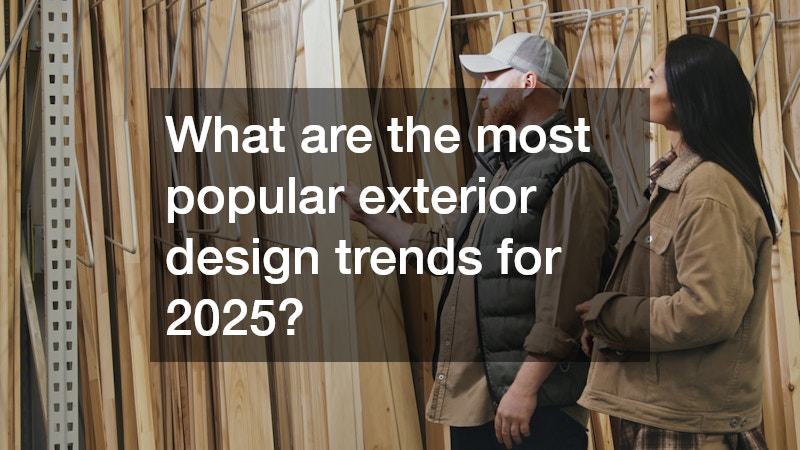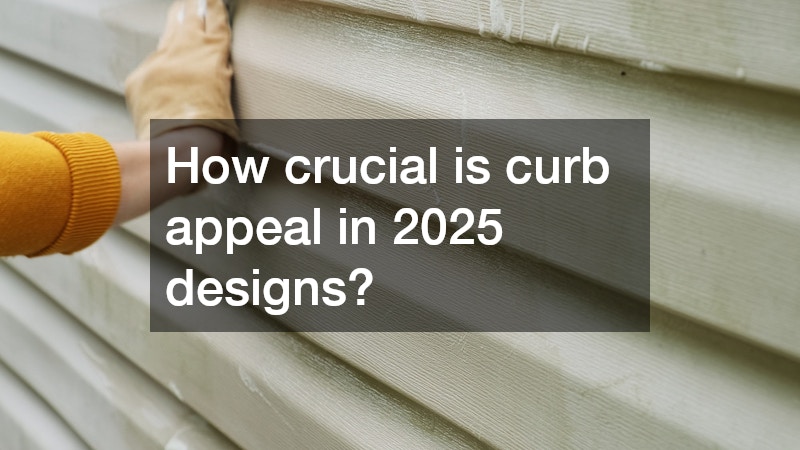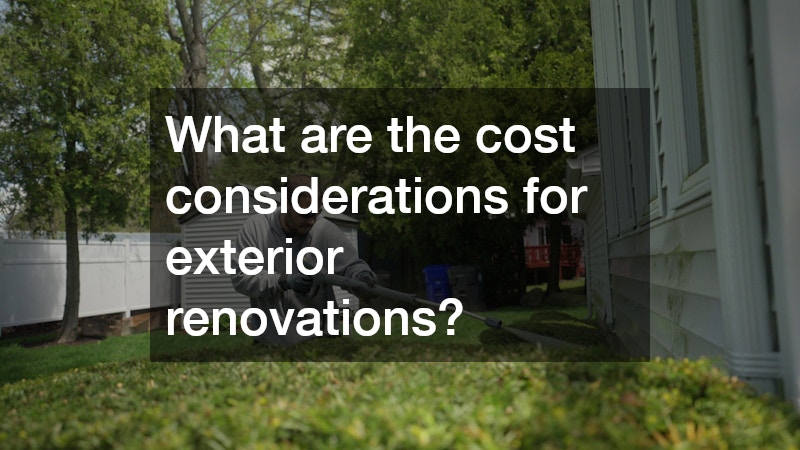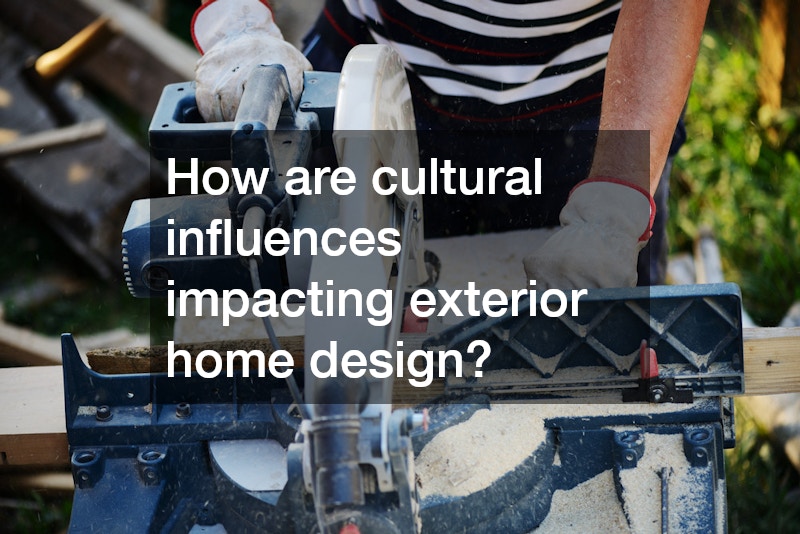As we look forward to 2025, the world of exterior home renovations and design is poised for significant transformation. Several key trends are emerging that reflect broader societal shifts and advancements in technology. Homeowners are increasingly prioritizing sustainability, integrating smart technologies, and drawing inspiration from biophilic design principles in their outdoor spaces. The demand for aesthetically pleasing and functional exteriors is shaping new innovations, from backyard fireplaces to cutting-edge exterior lighting. Key stakeholders, like local general contractors and masonry contractors, are pivotal in bringing these trends to life. The integration of land clearing services and demolition companies indicates a move towards redefining spaces entirely. Understanding these trends and key factors is essential for anyone looking to keep their exterior home renovations on the cutting edge in 2025.
What are the most popular exterior design trends for 2025?

One of the most talked-about trends for 2025 is hot tub installation. As homeowners seek to create relaxing and luxurious outdoor retreats, the appeal of a private hot tub cannot be underestimated. This trend reflects a broader desire to incorporate wellness and leisure into exterior home design.
Tbd, another trend gaining traction is the use of innovative outdoor materials that are both durable and stylish. Homeowners are looking for materials that offer longevity and complement the aesthetic of their homes. From composite decking to advanced weather-resistant paints, the choices are expanding.
Additionally, the integration of smart home technologies into exterior spaces is becoming mainstream. From smart garden irrigation systems to app-controlled outdoor lighting, technology is making outdoor environments more efficient and personalized. The challenge and opportunity for the industry is to seamlessly blend these innovations with traditional elements.
How is sustainability influencing exterior renovations?
Sustainability is more than a buzzword in 2025; it is a driving force influencing exterior renovations. Homeowners are increasingly mindful of their environmental footprint and seek ways to incorporate eco-friendly practices into their design choices. For instance, using recycled materials and sourcing locally can significantly reduce the carbon footprint of a renovation project.
Local general contractors often play a crucial role in guiding homeowners towards sustainable solutions. From recommending eco-friendly materials to ensuring energy-efficient construction methods, their expertise is invaluable. Furthermore, many contractors are now specializing in sustainability-focused renovations, responding to the rising demand.
Water conservation is another area where sustainability is making an impact. Advanced irrigation systems, rainwater harvesting, and drought-resistant landscapes are becoming staples in exterior design. Homeowners are not just interested in aesthetics but also in ensuring their outdoor spaces reflect an environmentally conscious lifestyle.
What innovations are shaping outdoor living spaces?
Roof installation technology continues to evolve, providing exciting new opportunities for outdoor living. Green roofs and solar-powered roofing materials are just two examples of how the industry adapts to meet energy efficiency needs. These innovations not only promote sustainable living but also offer thermal insulation and aesthetic appeal.
Tbd, multi-functional outdoor furniture is another trend gaining momentum. With more people entertaining and working from home, furniture that serves multiple purposes is in high demand. Pieces that combine seating, storage, and tables can maximize space without sacrificing style.
Outdoor kitchens are becoming more sophisticated and integrated. Beyond the traditional grill setup, homeowners now incorporate everything from pizza ovens to outdoor refrigeration units. These advancements are transforming backyards into comprehensive entertainment and dining spaces.
How crucial is curb appeal in 2025 designs?

Curb appeal remains a vital aspect of exterior design in 2025, with an emphasized focus on creating inviting and visually stunning entryways. The introduction of backyard fireplaces, for instance, adds a dynamic element that can be appreciated from both the interior and exterior of the home. These fireplaces serve as focal points and enhance the warmth of any space.
Incorporating native plants and landscaping features contributes to both curb appeal and sustainability efforts. By selecting vegetation that requires minimal maintenance and is well-adapted to local climates, homeowners can ensure their exteriors remain vibrant year-round while reducing water usage. Tbd, such landscaping choices also offer habitat benefits for local wildlife.
Facades and cladding materials are seeing innovations with modern textures and colors. Masonry contractors are incorporating vibrant stonework and mixed materials to create unique exterior looks. This evolution in design reflects a broader trend towards personalization and smarter use of materials in exterior projects.
What role do smart home technologies play in exterior design?
Smart home technologies are revolutionizing contemporary exterior designs by introducing convenience, security, and efficiency. From intelligent lighting systems that adjust automatically for mood, weather, and energy savings to app-controlled irrigation systems that monitor soil moisture, technology is becoming an essential component of outdoor living. Automated garden tools, such as robotic lawnmowers and smart sprinkler systems, make maintenance effortless and environmentally responsible. These advancements enable homeowners to manage their exterior spaces with precision, optimizing energy use and promoting sustainability while maintaining aesthetic appeal.
The role of land clearing services in preparing for smart installations is increasingly recognized. Proper grading, soil stabilization, and utility preparation ensure that wiring, sensors, and other technological components are installed safely and effectively. Early collaboration between landscapers, electricians, and smart tech specialists helps prevent future issues and ensures seamless integration of systems. As technology continues to evolve, having a solid infrastructure is key to adaptability and long-term performance.
Moreover, security features such as smart locks, video doorbells, surveillance cameras, and motion detectors are now standard components of exterior design. These tools not only enhance peace of mind but also increase property value by adding a layer of intelligent protection. The ongoing design challenge is to incorporate these innovations subtly, blending functionality with architectural harmony.
How are homeowners incorporating biophilic design?
Biophilic design in 2025 is about seamlessly connecting nature with built environments. Homeowners are increasingly adopting these concepts to enhance wellbeing, reduce stress, and create spaces that feel alive and restorative. This design philosophy promotes the integration of natural light, ventilation, and greenery into every aspect of the home. Large glass windows, sliding doors, and skylights allow for abundant sunlight and outdoor visibility, while vertical gardens and green walls bring organic textures into built environments. The goal is to create homes that nurture both physical and emotional health by blending indoor comfort with the rejuvenating qualities of nature.
Engaging demolition companies to reconfigure existing structures can facilitate the creation of new biophilic spaces. Removing unnecessary partitions or opening walls to connect with outdoor areas allows natural elements to flow through the home. This transformation fosters a sense of openness and balance that aligns with the principles of sustainability and mindful living.
Additionally, water features such as ponds, fountains, and waterfalls are being integrated as focal points in exterior designs. These additions not only enhance aesthetic appeal but also contribute to a calming ambiance through their gentle sounds and movement. The merging of natural elements—light, air, water, and greenery—underscores the growing significance of biophilia in modern architecture and exterior design.
What are the cost considerations for exterior renovations?

When considering exterior renovations, cost remains one of the most significant factors driving decision-making processes. The services of masonry contractors, for example, can vary significantly depending on material choice, project scale, and craftsmanship requirements. Homeowners must plan their budgets carefully to balance aesthetics with practicality. Choosing the right materials—such as brick, stone, or concrete—affects not only the overall appearance but also the longevity and maintenance costs of the renovation.
Working with a local general contractor allows homeowners to receive tailored advice on maximizing design value while adhering to financial constraints. These professionals can provide accurate cost estimates, manage timelines, and coordinate subcontractors efficiently. Such collaborations often reveal cost-saving opportunities through strategic planning, bulk material purchases, and efficient use of resources. Additionally, incorporating sustainable materials and energy-efficient technologies can lead to substantial long-term savings, offsetting higher upfront expenses with reduced utility and maintenance costs over time.
Understanding the full scope of renovation costs, including unforeseen expenses, is essential for project success. Elements such as permits, zoning regulations, landscaping restoration, and potential structural repairs can significantly influence overall budgets. A transparent discussion with contractors about contingencies ensures that financial expectations remain realistic. By proactively managing these factors, homeowners can minimize surprises and achieve a high-quality renovation that aligns with both vision and budget.
How is technology influencing exterior lighting?
Exterior lighting in 2025 has seen considerable advancements with technology playing a pivotal role. Smart lighting systems now offer customizable options that can be controlled via smartphones and integrated with other home automation systems. These systems provide homeowners with unprecedented control over the ambiance, security, and energy efficiency of their exteriors. Lighting can now adapt automatically to different times of day or weather conditions, helping to create welcoming, well-lit outdoor environments while minimizing energy waste.
Gutter contractors are adapting to accommodate new lighting systems that require strategic placement. For example, incorporating LED strip lights into gutter frameworks can enhance night-time aesthetics without being intrusive. These hidden light sources highlight architectural lines and landscaping features, producing a sophisticated and cohesive exterior look. Such integrations exemplify how traditional elements are evolving with technological advancements to blend form and function seamlessly.
Furthermore, advances in solar lighting technology allow for eco-friendly illumination solutions that do not compromise on brightness or functionality. Modern solar fixtures now feature improved battery storage, smart sensors, and weather-resistant designs, making them reliable year-round. Solar-powered lights require minimal maintenance and are ideal for pathways, gardens, and security applications. The sustainability benefits further complement the broader trend toward environmentally conscious exterior designs, where innovation meets practicality.
What are the latest trends in outdoor furniture design?
Outdoor furniture design in 2025 is highly influenced by the need for durability, style, and sustainability. Shingle roofing over patio areas, for instance, has sparked demand for weather-resistant furniture made from recycled and sustainable materials. This trend ensures that furniture not only complements the aesthetic but endures the elements with ease. Homeowners are increasingly conscious of long-term value, investing in pieces that combine eco-friendly craftsmanship with refined design. Manufacturers are responding by producing collections using reclaimed wood, marine-grade metals, and quick-dry, UV-resistant fabrics that maintain their appearance and strength for years.
Modular furniture is also becoming increasingly popular. Pieces that can be reconfigured or expanded allow for flexibility in hosting gatherings of varying sizes. This adaptability caters to the modern lifestyle, where versatility and minimalism are highly valued. Many modular systems now incorporate hidden storage, built-in charging ports, and convertible features that shift seamlessly from dining to lounging. This balance of practicality and innovation ensures outdoor furniture meets the evolving demands of multifunctional living spaces.
Aesthetic trends are gravitating toward sleek lines and neutral palettes that create a timeless look. Incorporating natural elements like wood and stone further enhances the connection with the outdoors. By balancing functionality with beauty, these furniture designs elevate the overall experience of outdoor living, creating spaces that are as inviting as they are enduring.
How are cultural influences impacting exterior home design?

Cultural influences are leaving a significant mark on exterior home design trends for 2025. Diverse stylistic elements, inspired by global architecture, enrich home aesthetics. From Mediterranean-inspired facades to Zen gardens, pool companies are helping integrate these features into a cohesive exterior design.
The fusion of cultural motifs and local traditions is more prominent than ever. Blending local materials with design elements inspired by different cultures can create unique exteriors. Tbd, cultural influences are not just about aesthetics; they often incorporate functional innovations suited to specific climates and landscapes.
Additionally, the role of artisans and craftsmen is respected in bringing cultural elements to life. The skilled application of intricate tilework, carvings, and other materials helps realize homeowners’ visions of culturally-rich spaces. This trend underscores a broader movement toward personalized, meaningful home environments.
As we venture into 2025, the landscape of exterior home renovations and design is characterized by remarkable trends and innovations. From the integration of smart technologies and sustainable practices to cultural influences and biophilic design, homeowners have a myriad of exciting options. Trends like hot tub installation, backyard fireplaces, and the use of advanced roofing and lighting technologies are reshaping how we experience outdoor living. Local general contractors and specialized service providers remain instrumental in this dynamic industry, ensuring that projects align with new demands and homeowner aspirations. The convergence of aesthetics, functionality, and sustainability will undoubtedly continue to define the future of exterior home design.



